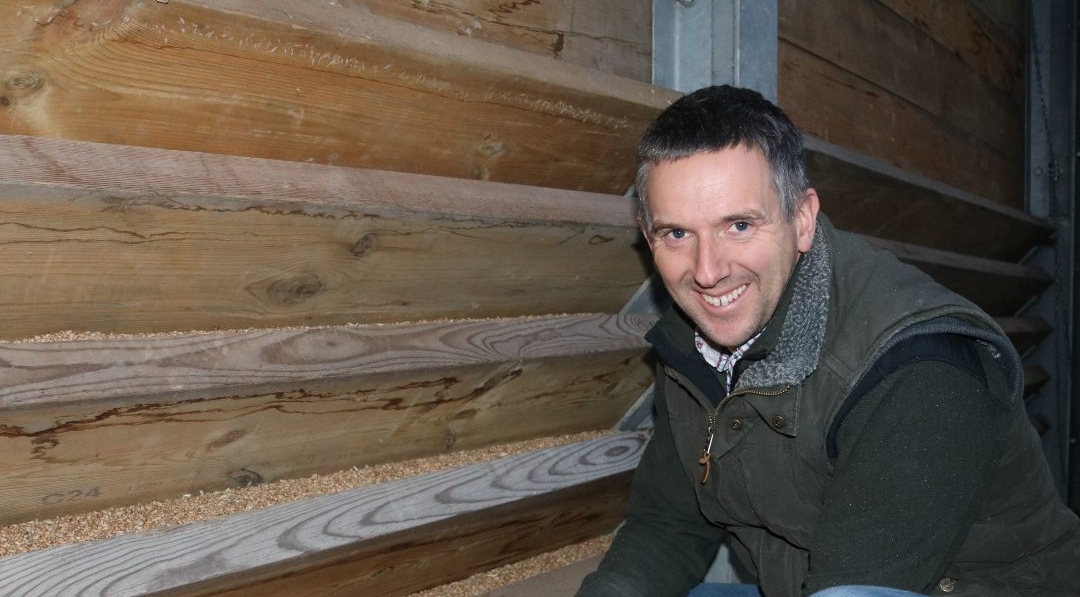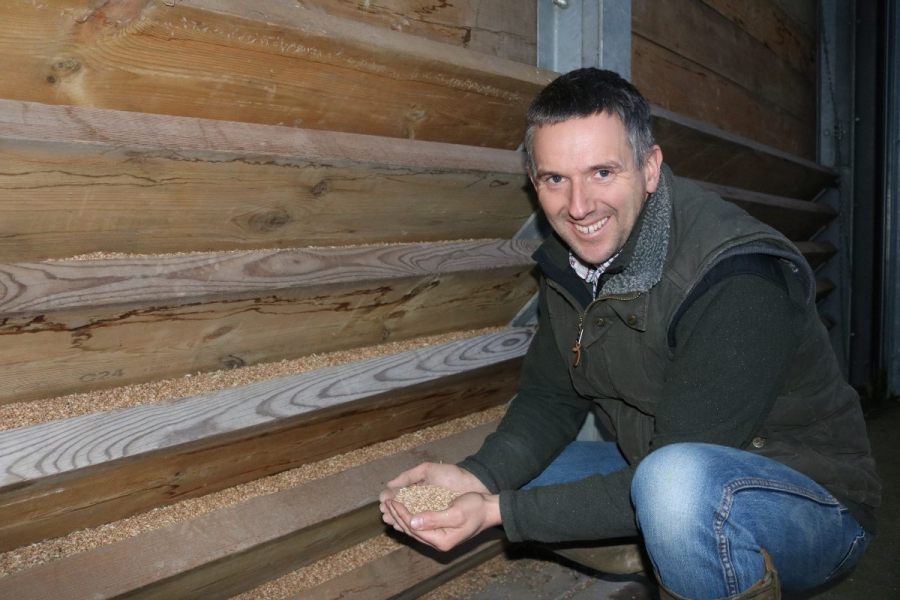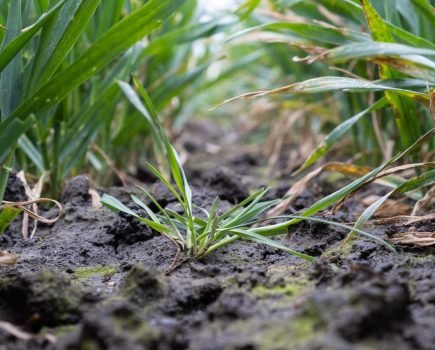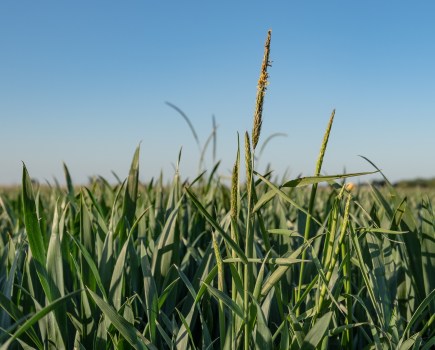
With a potential £1M worth of wheat to protect, CPM finds out how Kent farmer Richard Budd is approaching disease control and fertiliser use this spring.
Interest rates from the bank are next to nothing, so we tend to hedge inputs.
By Mike Abram
There’s a point in our conversation where Richard Budd lays out what’s at stake this season. “We’ve got 500ha of milling wheat in the ground. We work roughly on 10t/ha yield, so I’m hoping for 5000t in the shed – that’s potentially worth over £1M.”
It’s one of the reasons why the Kent farmer describes himself as a hedge fund manager as much as an arable farmer. “If you can hedge your inputs right and sell your outputs right, it’s possible to grow some fairly average crops and still make some really good margins. It doesn’t seem particularly fair but it’s the way we’re going, so you have to be bold when you sell and when you buy.”
Since CPM’s last visit (January 2020) he’s taken on around another 400ha of arable land, including a block of 200ha late last year, and is now growing 1200ha of arable crops from his base at Stevens Farm, Hawkhurst, approximately halfway between Royal Tunbridge Wells and Hastings. In addition, there’s just under 160ha of fruit and around 40ha of grass.
“It’s always been in our business plan to increase the size of our arable business,” he says. “We’ve tended to invest in kit that’s slightly larger than we needed since we started expanding the business 12 years ago.”
Kent isn’t the easiest area to pick up land. “It tends to be quite diverse – there’s grazing, vines, fruit and arable, so when areas come up, they are highly prized. We’ve been fortunate to pick up a couple of bits in the past couple of years that fit.”
In doing so, it’s also increased focus on the efficiency of the existing holding – with one eye also on reducing government funding – to critically examine which blocks are making money and fit the system. That’s led him to giving up around 60ha of farm business tenancies in smaller parcels which have become less important to the business.
“Sitting down and looking at what our farming portfolio is has been quite constructive over the past year or so, a process helped by these new bits of land coming up.”
Another new addition to the farm is a Sumo DD direct disc drill, which joins the existing Sumo DTS strip drill. It’s taken over drilling around 25-30% of the area, but purely based on soil conditions. “We’ve forced it in a few places to see what it would do and ended up needing to go back. The most important thing we’ve found is having a relatively dry window for seed to chit, while the DTS will put up with more rain.”
Cereal drilling started with BYDV-resistant winter barley varieties, Rafaela and Sensation on lighter land in late September, before 45mm of rain on 2 October delayed the first drilling window for wheat until 9 October. Then 10 days later a further 50mm brought another temporary halt, with drilling completed through November. “It was one of the most protracted drilling sessions I’ve ever known.”
Wheat varieties have been pared back to just five, from the more usual six or seven, with a couple only taking small areas. That’s partly to avoid varieties with the failing Cougar septoria resistance gene, and also through the lack of choice in milling varieties which make up the bulk of his crop.
“There’s not many homes for feed wheat here, so we grow Group 1 and 2s for the London mills, and a certain amount of Group 3, which is increasingly also going there rather on boats outs of Rye or Dover.”
KWS Zyatt has been the big winner on the farm, increasing its area to 200ha after a “stellar” year last season, while Skyfall now makes up just 50ha, after an “apocalyptic” season. “We had blocks of Zyatt doing double what Skyfall was doing. There was something Skyfall didn’t like last year – it fell off a cliff. I don’t think it was all down to disease – I think some of it was due to the 21 frosts we had in April and the Skyfall being a little further on, so the frosts knocked out a lot of grain sites.”
The Group 3 remains Elicit, after Firefly also bombed last year, while there’s a small area of Crusoe against his better judgement, he says. The other main variety is the Group 2 KWS Extase, which Richard says local merchants are suggesting could make Group 1 quality.
“I’m not sure they have looked at the price of fertiliser, and how much you would need to get it to 13%. I can get it to 11.5-12% on a sensible regime, but I’m not willing to take the risk to get it to 13%.”
That’s even having bought most of his nitrogen fertiliser at or below £250/t in the previous season. “Interest rates from the bank are next to nothing, so we tend to hedge inputs.”
With 500t of old stock in store ahead of the season, the only extra required was a “painful” 100t of nitrogen bought just before Christmas because of the new land purchase. “Obviously we’re in a sticky position for next year so I just hope prices comes back.”
But for this season it has put Richard in a good place to chase milling wheat premiums on the Group 1s. “Every farming conference has sessions on how to reduce nitrogen or make its use more efficient, so you can see there being a lot of low-grade milling wheat floating around after harvest. But if you have a shed of 13% milling wheat, my guess is that premiums are likely to be pretty healthy.
“So it might be high risk, but I think it’s the year to push Group 1s if you have nitrogen available.”
That’s also his attitude to protecting crops from disease. “I tend to work on the basis we’re going to get rain at some point, and that rain can be quite damaging to your potential yield in driving disease.
“Early on, I want to eradicate any disease in the bottom of the crop and not let it come up the plant. Then I want to protect my green leaf area.
“One thing I’ve learned from being involved in YEN trials over the past few years is that green leaf area is king – the longer you can keep it, the bigger the yield. I want to see at T3 that ideally leaves four, and even five, are still contributing to the overall yield and not just relying on leaves one and two.”
Up until last year Richard thought yellow rust was pretty easy to contain, but driven by 100mm of rain in May and a further 90mm in June, both yellow rust and septoria threatened.
“Without a sensible programme we would have lost a lot of crop. Fields going from green to bright yellow in the space of seven days wasn’t uncommon in some parts of Kent.”
Septoria was equally damaging later in the season, with some neighbouring crops that looked “stunning” in March and April, doing 4-5t/ha rather than 10t/ha, he says.
“The economics of not doing a proper septoria programme last year were massive, and that was when wheat was at £160/t and fertiliser was £200/t. If you’re going to do the same this year with fertiliser at £700/t and wheat £200/t plus already, you have some big cojones,” exclaims Richard.
“And with the potential for wheat to go even higher depending on Russia/Ukraine, are you really going to do nothing for septoria, even if it’s dry? I won’t be.”
His programme will almost certainly start with tebuconazole at T0 to clean out any yellow rust or septoria in the crop before applying Revystar (fluapyroxad+ mefentrifluconazole) at T1. Timing is critical, he says.
“I’d rather put on T1 when the whole of leaf 3 is out on the main tillers rather than just a little bit out, otherwise you’re not really achieving what you want to. And as we saw this year, if you then get some poor weather you can end up with a massive gap to T2.”
Being part of the Real Results trials programme has helped drive his product choice. “We were lucky to have it in trials pre-approval, and the results have shown that it’s a valuable tool for us,” he concludes.
Trials results showed real benefit of early disease control
April was dry. Twitter was full of growers suggesting fungicides could be cut back or even dropped altogether at those early timings. But on Richard’s farm in Kent, the Real Results trial suggested that wouldn’t have been a good plan.
The crop of KWS Zyatt, drilled in mid-October following spring beans, had two tramlines each treated with three different programmes: a field treatment, a BASF programme and a competitor treatment (see table).
In the case of Richard’s trial the key comparison was Elatus Era (benzovindiflupyr+ prothioconazole) in the field treatment against Revystar (mefentrifluconazole+ fluxapyroxad) at T1 in the BASF treatment.
A third tramline was treated with competitor products Elatus Era at T1, followed by Univoq (fenpicoxamid+ prothioconazole) at T2.
Disease incidence was assessed in early July, with septoria severity significantly lower on the flag leaf in the BASF treatment, with a lower green leaf area in both the field and competitor treatments. The average measured yield for the field treatment was 11.20t/ha. The modelled effect of the BASF treatment was to increase yield by 0.85t/ha to 12.05t/ha, while the competitor treatment increased yield by 0.33t/ha.
ADAS Agronomics statistical assessment indicated the difference between the BASF treatment and field treatment was statistically significant, while it wasn’t between the field and the competitor treatment.
That difference in performance was partly a result of Richard’s timings being spot on, according to Jonnie Dennis, agronomy manager in the south-east for BASF. “He didn’t rush out and apply T1 in April when it was cold and leaf three was probably not fully out. He’s waited and got the timing right at T1. Using the strongest product on septoria and rusts, Revystar, has then paid dividends.
“The trial also shows that using a strong rate of Univoq at T2 in the competitor programme hasn’t made up the ground lost by using the weaker T1.”
“It’s obvious that using a strong septoria product at T1 is critical, even if it’s dry,” adds Richard. “At best, weather forecasts are accurate for three to four days; they’re certainly not accurate for three to four weeks, so if you have crops with septoria in them, then you have to treat accordingly.”
The Real Results Circle
BASF’s Real Results Circle farmer-led trials are now in their sixth year. The initiative is focused on working with 50 farmers to conduct field-scale trials on their own farms using their own kit and management systems. The trials are all assessed using ADAS’ Agronomics tool which delivers statistical confidence to tramline, or field-wide treatment comparisons – an important part of Real Results.
In this series we follow the journey, thinking and results from farmers involved in the programme. The features also look at some in-depth related topics, such as SDHI performance and data capture and use.
We want farmers to share their knowledge and conduct on-farm trials. By coming together to face challenges as one, we can find out what really works and shape the future of UK agriculture.
To keep in touch with the progress of these growers and the trials, go to www.basfrealresults.co.uk




